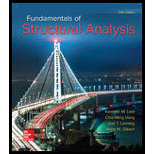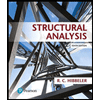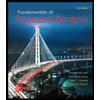
Concept explainers
(a)
Calculate the design wind load, base shear, and overturning moment.
(a)
Answer to Problem 18P
The resultant force acting on roof slab is
The resultant force acting on second floor is
The seismic base shear is
The overturning moment is
Explanation of Solution
Given information:
The importance factor (I) is 1.15.
The value of
The mean roof height is 30 ft.
The height of the single floor (h) is 15 ft.
The basic wind speed is
The exposure is D.
Calculation:
Consider the exposure of the D.
Refer Table 2.9, “Adjustment factor
The value of
Calculate the design wind pressure as shown below.
Refer Table 2.8 “Simplified horizontal design wind pressure
Calculate the design wind pressures for zone A and zone C as shown in Table 1.
| Zone | ||
| A | 12.8 | 24.44 |
| C | 8.5 | 16.23 |
Calculate the resultant force for each level as shown below.
The distance at which the load acts for zone A is
The distance at which the load acts for zone C is
Calculate the resultant force acting on roof slab as shown below.
Hence, the resultant force acting on roof slab
Calculate the resultant force acting on second floor as shown below.
Hence, the resultant force acting on second floor
Calculate the base shear force as shown below.
Hence, the seismic base shear is
Calculate the overturning moment as shown below.
Therefore, the overturning moment is
(b)
Calculate the base shear and overturning moment using the equivalent lateral force procedure.
(b)
Answer to Problem 18P
The seismic base shear is
The overturning moment is
Explanation of Solution
Given information:
The average weight of the floor and roof is
The value of
The value of
The value of R is 8.
The importance factor (I) is 1.5.
Calculation:
The value of
Calculate the fundamental period as shown below.
Calculate the total dead load of the building as shown below.
Calculate the magnitude of the base shear as shown below.
Calculate the magnitude of the maximum base shear as shown below.
Calculate the magnitude of the minimum base shear as shown below.
Hence, take the value of
The value of k is 1 for
Calculate the seismic base shear to each floor level as shown below.
Provide the calculated the seismic base shear at each floor levels as shown in Table 1.
| Floor | Weight | Height of the floor | |||
| Roof | 900 | 30 | 27, 000 | 0.667 | 39.5 |
| 2nd | 900 | 15 | 13,500 | 0.333 | 19.7 |
| Sum | 1,800 | 40,500 | 59.2 |
Refer to Table 1:
The seismic base shear is
Hence, the seismic base shear is
Calculate the overturning moment as shown below.
Therefore, the overturning moment is
(c)
Provide the design strength of the building govern the wind force of seismic force.
(c)
Answer to Problem 18P
The design strength of the building governed by the seismic force.
Explanation of Solution
Given information:
The average weight of the floor and roof is
The value of
The value of
The value of R is 8.
The importance factor (I) is 1.5.
Calculation:
Refer to part (a).
The seismic base shear and overturning moment due to wind force.
The seismic base shear is
The overturning moment is
Refer to part (b).
The seismic base shear and overturning moment due to seismic force.
The seismic base shear is
The overturning moment is
The seismic base shear and overturning moment due to seismic force is greater than to compared with the seismic base shear and overturning moment due to seismic force.
Hence, the design strength of the building governed by the seismic force.
Want to see more full solutions like this?
Chapter 2 Solutions
Fundamentals of Structural Analysis
- 8. A prestressed concrete beam is subjected to the following stress distributions: Pi is the initial prestressing force, Pe is the effective prestressing force, M, is the bending moment due to self- weight, Ma and M, are the dead load and live load bending moment, respectively. The concrete has the following properties: fr = 6000 psi and fri = 4200 psi +250 -85 -2500 +550 Pe+ Mo+Ma+Mi P alone P₁+ Mo -2450 -3500 Stress at midspan +210 +250 P, alone Pe alone -2500 -3500 Stress at ends Using Table 22.1, evaluate whether the stresses at the center of the span and the end of the span comply with the permissible stress limits. The beam is classified as U-class. Provide justifications for each condition listed in the table. Note: Calculated stresses are to be taken from the above diagram, and permissible stresses are to be calculated using Table 22.1. Compressive stresses immediately after transfer Tensile stresses immediately after transfer Compressive stresses under sustained and total…arrow_forward10. A short column is subjected to an eccentric loading. The axial load P = 1000 kips and the eccentricity e = 12 in. The material strengths are fy = 60 ksi and f = 6000 psi. The Young's modulus of steel is 29000 ksi. (a) Fill in the blanks in the interaction diagram shown below. (2pts each, 10pt total) Po Pn (1) failure range H 3" 30" Ast 6 No. 10 bars = P 22" I e H 3" (4) e = e small Load path for given e Radial lines show constant (2) eb (3) e large failure range Mn (5) e= Mo (b) Compute the balanced failure point, i.e., P and Mb.arrow_forwardNo chatgpt plsarrow_forward
- 11. The prestressed T beam shown below is pretensioned using low relaxation stress-relieved Grade 270 strands. The steel area Aps = 2.5 in². The tensile strength is fpu = 270 ksi, and the concrete compressive strength is fr = 6000 psi. (a) Calculate the nominal moment strength Mn with hr = 6 in. 22" 15" T hf (b) Since this beam is a T-beam, the nominal moment strength M₁ increases with a thicker hf. However, M, stops increasing if he reaches a value. Determine the minimum thickness hy that can achieve the maximum nominal moment strength Mr. Also, calculate the corresponding maximum nominal moment strength Mn with the computed hf.arrow_forward10. A short column is subjected to an eccentric loading. The axial load P = 1000 kips and the eccentricity e = 12 in. The material strengths are fy = 60 ksi and f = 6000 psi. The Young's modulus of steel is 29000 ksi. (a) Fill in the blanks in the interaction diagram shown below. 30" Ast 6 No. 10 bars = Pn (1) Po (4) e = e small Load path for given e failure range Radial lines show constant (2) eb (3) e large failure range Mn (5) e= Mo (b) Compute the balanced failure point, i.e., P and Mb. H 3" P 22" I e H 3"arrow_forward10. A short column is subjected to an eccentric loading. The axial load P = 1000 kips and the eccentricity e = 12 in. The material strengths are fy = 60 ksi and f = 6000 psi. The Young's modulus of steel is 29000 ksi. (a) Fill in the blanks in the interaction diagram shown below. 30" Ast 6 No. 10 bars = Pn (1) Po (4) e = e small Load path for given e failure range Radial lines show constant (2) eb (3) e large failure range Mn (5) e= Mo (b) Compute the balanced failure point, i.e., P and Mb. H 3" P 22" I e H 3"arrow_forward
- 7. Match the given strand profiles with the corresponding loading conditions for a prestressed concrete (PSC) beam. Strand profile (b) (d) (c) (a) Ꮎ Load on a beamarrow_forward4. For serviceability considerations, the effective moment of inertia (Ie) is calculated using the following formula: le 1 - 1cr ((2/3) Mcr) Ma 2 - وا ≥ Note that the upper bound was previously set as Iut in the earlier ACI equation. (a) Arrange the following moment of inertia values in ascending order (from smallest to largest): le, Ier, Ig and lut (b) Mer is the cracking moment. Choose the cross-section that should be used to compute Mcr. NA. h 5. Identify and circle the figure that represents the scenario in which the torsional effect is permitted to be reduced according to the ACI code provisions. (3 pts) mt mi B (b)arrow_forwardI will rate, thanksarrow_forward
- . 9. A reinforced concrete beam is subjected to V/ = 40 kips and Tu/ = 12 ft kips at the critical section. Given conditions: ⚫ Longitudinal reinforcements use No. 8 grade 60 steel with an effective depth d = 20 in. For shear capacity, V = 18 kips and V₂ = 22 kips • For transverse reinforcements, use No. 3 bars with grade 60. • The effective torsional area of A. = 150 in². • Crack angle = 45° ⚫ The minimum stirrup spacing is Smin = 4" and the maximum stirrup spacing is Smax = Find the required stirrup spacing at the critical section. 8".arrow_forward3. The beam shown on the right uses three No. 8 bars made of Grade 60 steel as longitudinal reinforcement. The allowable maximum center-to-center spacing of the longitudinal rebars has been determined to be 10 inches. Now assume that Grade 80 steel will be used instead. Determine whether the beam satisfies the rebar spacing requirements according to the ACI Code. Additional assumptions: • Estimate fs = fy • 20" Clear cover: ? 12" Clear side cover: 1.5" The clear cover depth cc and the clear side cover remain unchanged, regardless of the change in material.arrow_forward6. For the slender columns shown below: a) Determine the effective buckling length factor (k) for each column. b) Circle the column with the largest buckling capacity, assuming all columns have the same length (f) and the same flexural rigidity (E+I) k = (a) (b) (c) (d)arrow_forward

 Structural Analysis (10th Edition)Civil EngineeringISBN:9780134610672Author:Russell C. HibbelerPublisher:PEARSON
Structural Analysis (10th Edition)Civil EngineeringISBN:9780134610672Author:Russell C. HibbelerPublisher:PEARSON Principles of Foundation Engineering (MindTap Cou...Civil EngineeringISBN:9781337705028Author:Braja M. Das, Nagaratnam SivakuganPublisher:Cengage Learning
Principles of Foundation Engineering (MindTap Cou...Civil EngineeringISBN:9781337705028Author:Braja M. Das, Nagaratnam SivakuganPublisher:Cengage Learning Fundamentals of Structural AnalysisCivil EngineeringISBN:9780073398006Author:Kenneth M. Leet Emeritus, Chia-Ming Uang, Joel LanningPublisher:McGraw-Hill Education
Fundamentals of Structural AnalysisCivil EngineeringISBN:9780073398006Author:Kenneth M. Leet Emeritus, Chia-Ming Uang, Joel LanningPublisher:McGraw-Hill Education
 Traffic and Highway EngineeringCivil EngineeringISBN:9781305156241Author:Garber, Nicholas J.Publisher:Cengage Learning
Traffic and Highway EngineeringCivil EngineeringISBN:9781305156241Author:Garber, Nicholas J.Publisher:Cengage Learning





